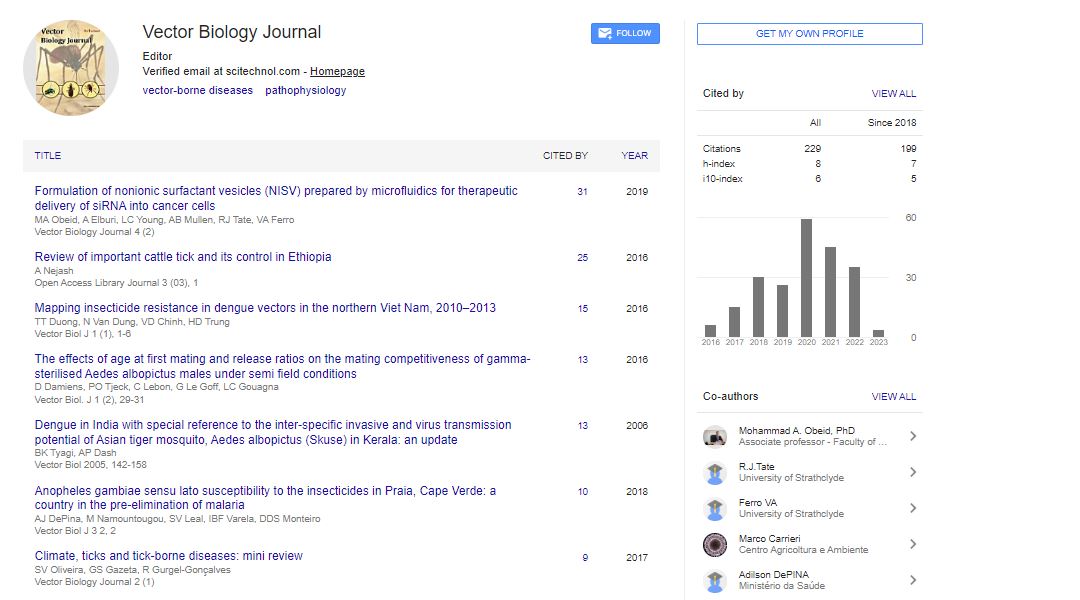Perspective, Vector Biol Vol: 8 Issue: 1
Host-Parasite Interaction Intricate Association between Organism
Suya Sim*
Applied Life Science Department, Sojo University, Kumamoto, Japan
*Corresponding Author: Suya Sim
Applied Life Science Department, Sojo
University, Kumamoto, Japan
E-mail: Huangkuan@123.com
Received date: 20 February,2023, Manuscript No. VBJ-23-95799;
Editor assigned date: 22 February, 2023, PreQC No. VBJ-23-95799(PQ);
Reviewed date: 09 March, 2023, QC No VBJ-23-95799;
Revised date: 16 March, 2023, Manuscript No. VBJ-23-95799(R);
Published date: 23 March, 2023, DOI: 10.4172/2473-4810.1000257.
Citation: Sim S (2023) Host-Parasite Interaction Intricate Association between Organism. Vector Biol 8:1.
Description
Host-parasite interaction is a fascinating phenomenon that occurs in various ecological systems where one organism known as the parasite benefits at the expense of another organism known as the host. This intricate relationship between the two organisms has been the subject of extensive study in fields such as biology, ecology, and medicine the dynamics of host-parasite interaction is important in elucidating the complex mechanisms underlying disease transmission, evolution, and ecological balance. Parasites are diverse and can belong to different taxonomic groups, including viruses, bacteria, fungi, protozoa, helminths, and arthropods. They can infect various hosts including plants, animals and even other parasites. The relationship between a parasite and its host can range from mutualistic where both organisms benefit to parasitic where the parasite benefits at the expense of the host.
Parasites have evolved various strategies to exploit their hosts and ensure their survival and reproduction. One common strategy is the direct consumption of the host's tissues and nutrients. For example, parasitic worms such as tapeworms and roundworms absorb nutrients from the host's digestive system depriving the host of essential nutrients and causing malnutrition. Similarly blood-sucking parasites like mosquitoes and ticks consume the blood of their hosts leading to blood loss, anaemia and the potential transmission of diseases. Another line of attack employed by parasites is the manipulation of the host's behaviour to their advantage. Parasites can alter the behaviour of their hosts to facilitate their own transmission. For instance, the parasitic wasp Hymenoepimecis argyraphaga lays its eggs on the abdomens of orb-weaving spiders. The wasp larva then feeds on the spider's blood while injecting a chemical that alters the spider's behaviour, forcing it to build a special web that is suitable for the wasp larva to pupate in. This manipulation ensures that the wasp larva has a suitable environment for its development and eventual emergence as an adult wasp.
Some parasites have evolved the ability to evade the host's immune system, allowing them to establish long-term infections. For example, the Human Immunodeficiency Virus (HIV) attacks and destroys immune cells, weakening the host's immune response and making it more susceptible to infections and diseases. Similarly, parasitic protozoa such as Plasmodium which causes malaria evade the host's immune system by rapidly changing their surface antigens making it difficult for the host's immune cells to recognise and eliminate them. This immune evasion allows the parasite to persist and reproduce within the host leading to chronic infections. Parasites also exhibit remarkable reproductive strategies to ensure their survival. Many parasites have complex life cycles that involve multiple hosts. For example, the parasitic flatworm Schistosoma mansoni requires a freshwater snail as an intermediate host to complete its life cycle, with humans as the definitive host. The parasite lays eggs in the blood vessels surrounding the human intestine, which are then excreted in faeces. The eggs hatch in water and the larvae infect snails, where they undergo further development. The snails release free-swimming larvae, which then penetrate the skin of humans who come into contact with contaminated water. This complex life cycle ensures the survival and transmission of the parasite to new hosts. In some cases, parasites can also cause behavioural changes in their hosts that increase their chances of transmission.
 Spanish
Spanish  Chinese
Chinese  Russian
Russian  German
German  French
French  Japanese
Japanese  Portuguese
Portuguese  Hindi
Hindi 